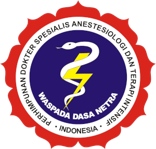Intra-Anesthetic Anaphylactic Shock Due to Rocuronium: Diagnosis and Treatment
Abstract
Introduction: Intraoperative anaphylactic events are rare, but are important to pay attention to as they are associated with morbidity and mortality rates. Intraoperative anaphylactic events can be caused by anesthetic drugs including muscle paralysis, rocuronium, succinylcholine and attracurium are the most common causes of intraoperative anaphylaxis.
Case Illustration: An 11-year-old girl diagnosed with 3rd degree microtia with severe conductive hearing loss in the right ear. It is planned to undergo stage 1 auriculoplasty measures accompanied by rib harvesting. After induction of anesthesia with the administration of rocuronium as a muscle relaxant. Patients are suspected of anaphylaxis due to a decrease in blood pressure, increased pulse and low EtCO2 levels. Anaphylactic management is done quickly so that the patient experiences good resolution.
Conclusion: The cause of anaphylaxis during intraoperative occurrence is caused by muscle relaxant, one of which is rocuronium where most likely the cause of anaphylaxis that occurs in patients due to rocuronium administration. In addition to observing the patient's blood pressure and pulse, a decrease in EtCO2 can be a sign of anaphylactic activity. The initial goals of anaphylactic treatment are improving cardiovascular homeostasis, intravenous epinephrine administration and intravascular volume replenishment. Proper recognition and management of intraoperative anaphylactic events will provide a good prognosis.
Keywords
Full Text:
PDFReferences
1. Dewachter P, Savic L. Perioperative anaphylaxis: pathophysiology, clinical presentation and management. BJA Educ. 2019;19(10):313-320. doi:10.1016/j.bjae.2019.06.002
2. Dewachter P, Mouton C, Emala C. Anaphylaxis and Anesthesia: Controversies and New Insights. Anesthesiology. 2009;111:1141-1150. doi:10.1097/ALN.0b013e3181bbd443
3. Reddy JI, Hannam JA. Anaphylaxis Is More Common with Rocuronium and Succinylcholine than with Atracurium. Perioper Med.
4. Anaphylaxis during general anesthesia, the intraoperative period, and the postoperative period. J Allergy Clin Immunol. 1998;101(6):S512-S516. doi:10.1016/S0091-6749(18)30584-0
5. Simons FER, Ardusso LRF, Bilò MB, et al. World Allergy Organization Guidelines for the Assessment and Management of Anaphylaxis. World Allergy Organ J. 2011;4(2):13-37. doi:10.1097/WOX.0b013e318211496c
6. Takahashi K, Tanaka S, Watanabe M, Yamakage M. Rocuronium-induced anaphylaxis: a case report. JA Clin Rep. 2019;5(1):81. doi:10.1186/s40981-019-0303-5
7. Admass BA, Hassen AE, Agegnehu AF, et al. Management of perioperative anaphylaxis: Systematic review. Int J Surg Open. 2023;52:100595. doi:10.1016/j.ijso.2023.100595
8. Golden DBK. Patterns of Anaphylaxis: Acute and Late Phase Features of Allergic Reactions. In: Bock G, Goode J, eds. Novartis Foundation Symposia. John Wiley & Sons, Ltd; 2008:101-115. doi:10.1002/0470861193.ch9
9. Yim DR. An update on PERIOPERATIVE ANAPHYLAXIS. Published online 2016.
10. Garvey LH, Dewachter P, Hepner DL, et al. Management of suspected immediate perioperative allergic reactions: an international overview and consensus recommendations. Br J Anaesth. 2019;123(1):e50-e64. doi:10.1016/j.bja.2019.04.044
11. Gouel-Chéron A, De Chaisemartin L, Jönsson F, et al. Low end-tidal CO2 as a real-time severity marker of intra-anaesthetic acute hypersensitivity reactions. Br J Anaesth. 2017;119(5):908-917. doi:10.1093/bja/aex260
12. Erlich C, Lamer A, Moussa MD, Martin J, Rogeau S, Tavernier B. End-tidal Carbon Dioxide for Diagnosing Anaphylaxis in Patients with Severe Postinduction Hypotension. Anesthesiology. 2022;136(3):472-481. doi:10.1097/ALN.0000000000004123
13. Butterworth JF, Mackey DC, Wasnick JD, Morgan GE, Mikhail MS. Morgan & Mikhail’s Clinical Anesthesiology. Sixth edition. McGraw-Hill Education; 2018.
14. Kim SM, Oh S hoon, Ryu SA. Treatment of rocuronium-induced anaphylaxis using sugammadex - A case report -. APM. 2020;16(1):56-59. doi:10.17085/apm.20074
15. Peavy RD, Metcalfe DD. Understanding the mechanisms of anaphylaxis. Curr Opin Allergy Clin Immunol. 2008;8(4):310-315. doi:10.1097/ACI.0b013e3283036a90
16. LoVerde D, Iweala OI, Eginli A, Krishnaswamy G. Anaphylaxis. Chest. 2018;153(2):528-543. doi:10.1016/j.chest.2017.07.033
17. Kolawole H, Marshall SD, Crilly H, Kerridge R, Roessler P. Australian and New Zealand Anaesthetic Allergy Group/ Australian and New Zealand College of Anaesthetists Perioperative Anaphylaxis Management Guidelines. Anaesth Intensive Care. 2017;45(2):151-158. doi:10.1177/0310057X1704500204
Refbacks
- There are currently no refbacks.








